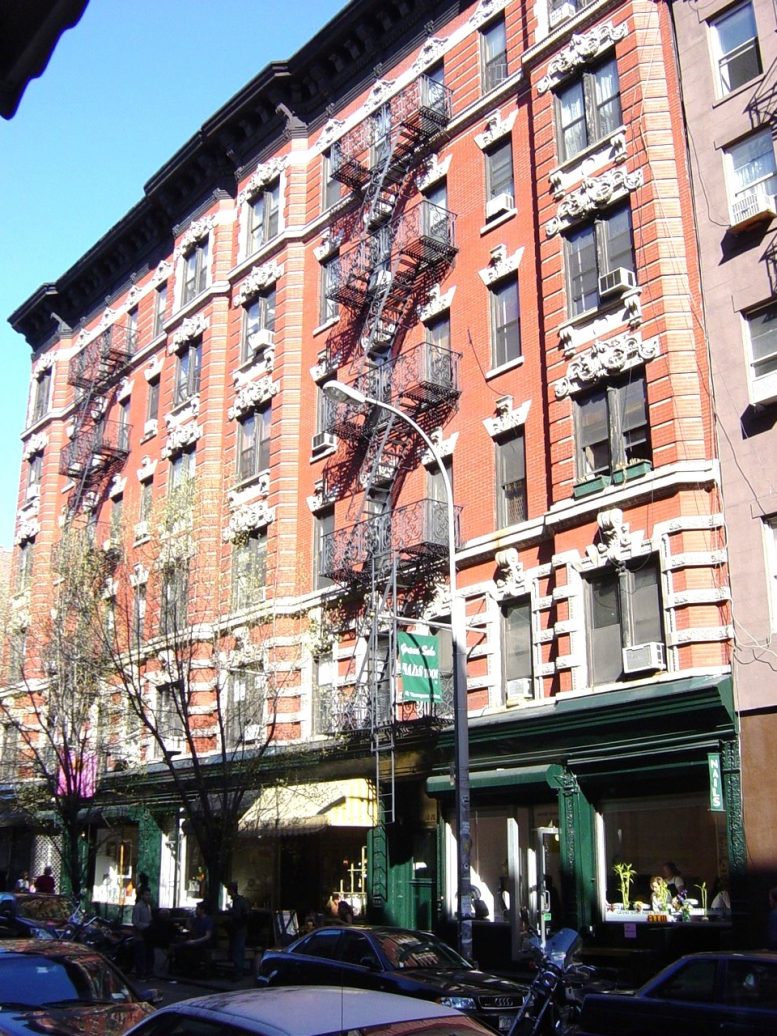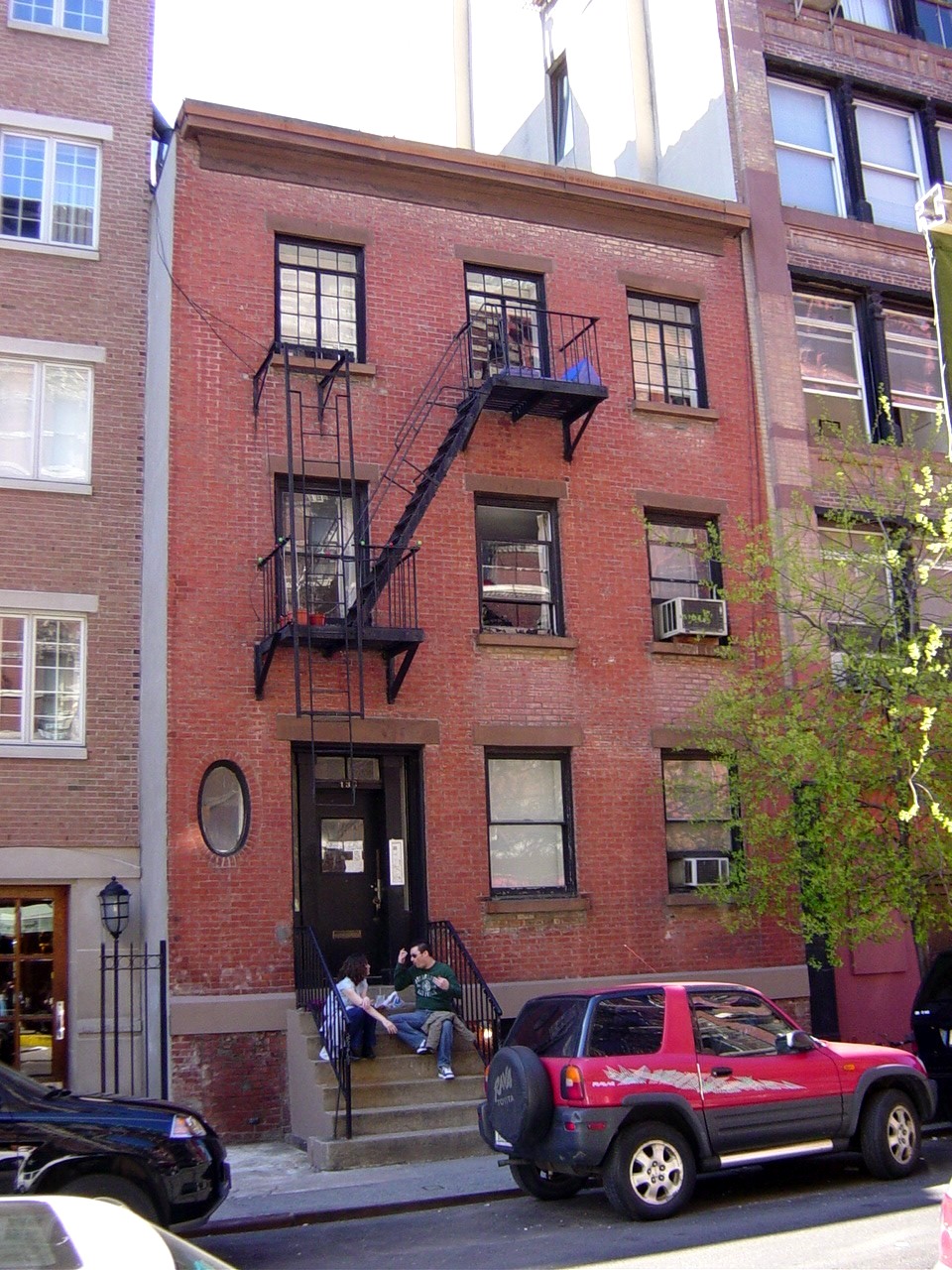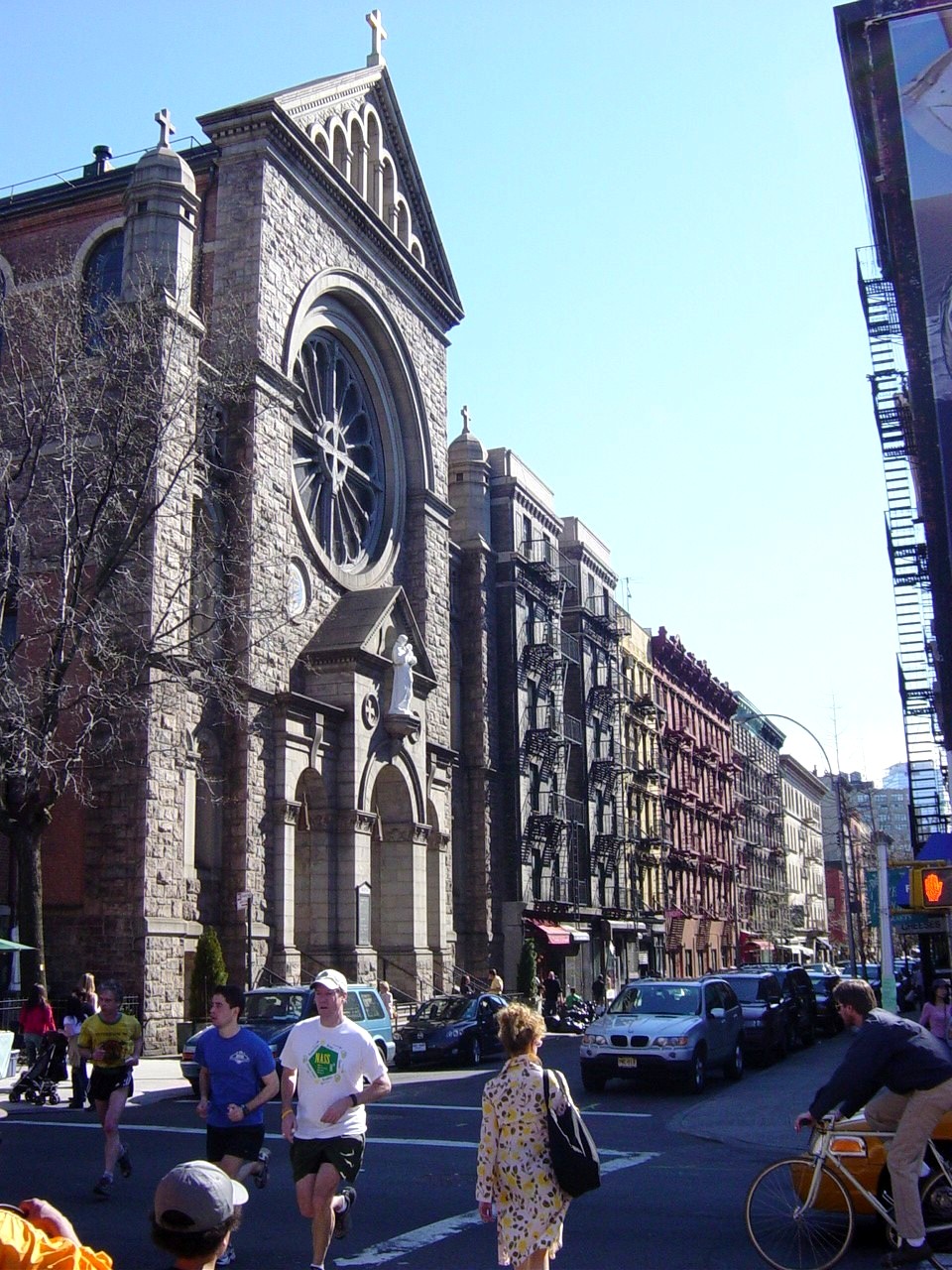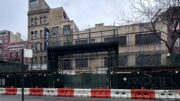A major part of a historic Greenwich Village area known as the South Village is one step closer to preservation. On Tuesday, the Landmarks Preservation Commission held a public hearing on the designation of the Sullivan-Thompson Historic District.
As YIMBY reported when the district was calendared earlier this month, the area would be bound by West Houston Street on the north, Watts Street on the south, Sixth Avenue (Avenue of the Americas) on the west, and Thompson Street on the east. Though the definition of SoHo is south of Houston, this district was historically considered part of Greenwich Village.
Most of the eastern edge of the district would border the SoHo-Cast Iron Historic District Extension. The northwest portion would bump up against the Charlton-King-Vandam Historic District. The MacDougal-Sullivan Gardens Historic District and South Village Historic District are both just a little north. The Sullivan-Thompson Historic District would mark what many consider the last major piece of preserving Greenwich Village.
The earliest portions of the proposed district date back to the 1810s, and the area’s population tripled by 1840. Of the approximately 157 properties to be included, 20 percent were constructed prior to 1850, 15 percent between 1851 and 1878, 20 percent between 1879 and 1900, 30 percent between 1901 and 1916, a single building between 1916 and 1929, and then 15 percent between 1930 and now. It is mostly residential with rowhouses, tenements, and apartment buildings, along with many historic storefronts.
Five individual landmarks would be contained in the area, as would a park – the Vesuvio Playground at the corner of Spring and Thompson streets. St. Anthony of Padua Church at 155 Sullivan Street would also be included.
Immigration is a major part of the history of this proposed district, starting with Irish and Germans and later Italians.
Thirty-four people rose to testify at the nearly two-hour-long public hearing. The vast majority spoke in support of designation. That included City Council Member Corey Johnson, who noted that the “historic blocks reflect the immigrant story.” Representatives of State Assemblywoman Deborah Glick and Manhattan Borough President Gale Brewer also spoke.
The key organization when it comes to advocating for this district’s designation has been the Greenwich Village Society for Historic Preservation (GVSHP). Speakers are given three minutes apiece. GVSHP’s informative testimony was so lengthy that it had to be delivered in two parts. The organization’s executive director, Andrew Berman, started and its director of research & preservation, Sarah Bean Apmann, concluded. It is published here in its entirety:
Good morning Commissioners, and thank you for the opportunity to testify. My name is Andrew Berman, and I am the Executive Director of the Greenwich Village Society for Historic Preservation. GVSHP is the largest membership organization in Greenwich Village, the East Village, and NoHo, and wholeheartedly supports designation of the proposed Sullivan-Thompson Historic District.
After meeting with the Landmarks Preservation Commission in 2002 and 2004 to pursue landmark designation for the entire South Village, in late 2006 GVSHP submitted a formal proposal with boundaries for a proposed South Village Historic District. At the time, the Landmarks Preservation Commission agreed to consider the proposed district in three phases. Most of first phase, west of 6th Avenue and north of Houston Street, was designated in 2010. Most of the second phase, between 6th Avenue and LaGuardia Place, north of Houston Street, was designated in late 2013. And we are very glad to see that more than 90% of the third and final phase of the proposed historic district, located between Houston and Watts Streets, east of Sixth Avenue, is now before you today to be considered for designation.
Reaching this point is a testament to literally thousands of people over the last ten years who have written the Commission, rallied, attended hearings, and signed petitions in support of designation. We are particularly grateful to City Councilmember Corey Johnson, who has worked unrelentingly to us to this point.
The area under consideration, like the rest of the South Village, is not only undeniably deserving of designation, but unquestionably in need of it. In 2012, the Preservation League of New York State named the entire South Village, including this area, one of its “Seven to Save,” or one of the seven most important, endangered historic sites in the State. In 2013, the entire South Village, including the proposed Sullivan-Thompson Historic District, was listed on the State and National Registers of Historic Places, for its architectural and historic significance, especially in relation to immigrant history.
Sadly, in the last several years many of the district’s significant historic structures have been lost due to the lack of landmark protections. This includes the 1922 Tunnel Garage, one of the earliest and most beloved Art Deco structures in New York; the 1820 Ezra Weeks-Daniel Ludlow House at 54 MacDougal Street, a structure connected not only to its namesakes but to Aaron Burr and Alexander Hamilton; and 186 Spring Street, an 1824 federal style rowhouse determined individually eligible for the State and National Registers of Historic Places for its exceptional significance in connection to post-Stonewall LGBT history.
Compounding the tragic loss of these and many other structures in the area is the fact that current zoning could allow new construction here up to 300 feet in height, which is woefully out of character for this uniformly low-scaled district. Developers such as Donald Trump son-in-law Jared Kushner have recently bought up properties in the area. Only landmark designation will prevent more such losses and inappropriate development.
The proposed designation before you is more than ten years in the making, and captures two centuries of New York’s history and evolution. With yet another proposed rezoning on this district’s edges right now that will increase development pressure, this is the time to act. We urge you in the strongest of terms to approve the proposed historic district as soon as possible, and finish the job of extending landmark protections to the entire South Village.
The one hundred sixty buildings of the proposed Sullivan Thompson Historic District contain a rich and unrivalled array of buildings which speak to New York’s explosive growth in the 19th and early 20th century. It speaks particularly powerfully to New York’s role as a mecca for innovators and immigrants, in this case especially Italian-Americans, who were once the single most populous ethnic group in New York City.
In examining this area one is immediately struck by the incredible St. Anthony of Padua Church and its related buildings. The oldest buildings are the striking Romanesque Revival church on Sullivan Street and the imposing Second Empire style friary on Thompson Street. Constructed in 1886, these buildings form the oldest extant Italian-American Church in the country, part of the very first Catholic parish established in 1859 to serve Italian-Americans. Subsequent buildings constructed by and for the church in the neo-Classical, post-modern, and mid-century modern ecclesiastical style create a substantial imprint upon this section of the South Village.
The district also contains several houses constructed in the Federal or Greek Revival style from the beginning of the 19th century through the 1830’s. Some are in pristine condition and have barely changed in almost two hundred years; others have been tenementized almost beyond recognition.
However by far the lion’s share of buildings in this district, and what arguably forms its heart, are the tenements constructed from the mid-19th to the early 20th century. This section of the South Village arguably has perhaps the most impressive collection of largely intact tenements in every conceivable style and configuration. This includes pre-law, old-law, and new law tenements, as well as an exceptional collection of reform housing tenements faced with white glazed brick. Built in the second decade of the 20th century by Dominick Abbate’s Citizen’s Investing Company, these five remarkable New York buildings can only be found on Sullivan and Thompson Streets.
There are few parts of New York where one can walk down streets and see what an immigrant community at the turn of the last century, during the last great wave of immigration to New York City, looked like. Not only do these tenements have surprisingly rich and beautifully detailed facades, but in this area a remarkable number of them maintain intact their original cornices, ironwork, entryways, wooden doors and wooden or cast iron storefronts. This irreplaceable detail, which has miraculously survived here as it has in very few other places, gives these streets a distinctive and irreplaceable feel which can only be preserved by landmark designation.
This impressive array of housing for New York’s working class immigrants shows how the laws governing housing changed through the late 19th and into the early 20th centuries. Four story pre-law tenements covering nearly their entire lots gave way to five-story old law tenements with small “dumbbell” cutouts to afford a minimum of light and air into each room, which in turn were replaced by new law tenements, some of which rose to six or seven stories without an elevator, but which gave each room and apartment a more meaningful source of light and air. These in turn gave way to “H”-plan reform housing and model tenements, whose simple but clean style and improved amenities harkened towards the urban renewal developments and middle- and upper-middle-class white brick apartment buildings which became so ubiquitous in New York in the mid-20th century.
Nearly every style of late 19th to early 20th century New York is represented here, from Neo-Renaissance to Neo-Grec, Romanesque Revival to Arts and Crafts. This remarkably well-preserved neighborhood cries out for landmark protections, which we hope the Commission will act swiftly to provide.
The Historic Districts Council, another major preservationist organization, also had informative testimony, delivered by Barbara Zay, its manager of preservation & research. It noted the lack of recognition for the Lower East Side:
The Historic Districts Council fully supports the designation of the Sullivan-Thompson Historic District. The proposed district has a distinct character from the cocoon of historic districts surrounding it. It most notably demonstrates New York City’ s evolution of housing development spanning two centuries, as well as manufacturing, institutional and commercial historic buildings. Moreover, this neighborhood was home to a large African American population in the mid-19th century, and later many European immigrants. The area is notorious for its cultural and artistic associations, as well.
In short, this neighborhood is the picture of all of the attributes that a historic district should have, despite some alterations and examples of insensitive construction that has occurred in recent years. We hope that as the owners of historic buildings in this new district apply for permits, the Commission evaluates any proposed changes in light of the district’s cultural importance, as this area has already suffered the loss of such cultural landmarks (with a lower case ‘l’) as the Circle in the Square Theater and the Sullivan Street Playhouse.
While this neighborhood contains buildings in an array of ages and styles, the tenement is the dominant building type to the pedestrian eye. If the Commission is interested in protecting tenement neighborhoods, we would encourage consideration for the designation of portions of the Lower East Side, which even more powerfully conveys the city’s diversity of tenement architecture and whose links to the immigrant experience in New York City is of local, national and international significance. While HDC is happy that the majority of Manhattan Community District 2 now enjoys landmark status, other historic sections of lower Manhattan are rapidly disappearing.
“This district stands on its own,” said Tobi Bergman, chair of Manhattan Community Board 2. CB2’s Teri Kude also spoke, though as a private citizen, echoing Mr. Bergman.
An architectural historian for the New York Landmarks Conservancy called the proposed district “a part of the narrative of New York City.” Christabel Gough of the Society for the Architecture of the City and Hilda Regier of the Victorian Society also rose in support of designation.
“If you allow our history to be taken away, you take away part of our soul,” said land use litigator Evelyn Conrad. One resident was overjoyed to live in this area after having lived in what she called the “boring” Upper East Side. Another lamented the hour of sunlight lost following the construction of the Trump Soho hotel.
There were about a handful of people who rose in straight-out opposition to designation or at least in opposition to the proposed boundaries. Among them was Joseph Rosenberg of the Catholic Community Relations Council of New York. As YIMBY has often reported, religious institutions are usually especially opposed to landmark designation. This district, with a church and a religious school, is no exception.
A couple of other property owners also testified. Steve Hamilton called for the exclusion of areas of Sixth Avenue, saying to the commissioners, “You will have created a museum, but destroyed a community.” Another owner, Kenneth Rosenblum, complained of preservation of “overbuilt” tenements.
The commission is scheduled to vote on designation on Tuesday, December 13.
Subscribe to YIMBY’s daily e-mail
Follow YIMBYgram for real-time photo updates
Like YIMBY on Facebook
Follow YIMBY’s Twitter for the latest in YIMBYnews









Famous and should be remembered on, notwithstanding two centuries support noteworthy designation.